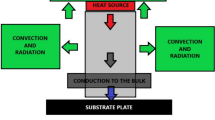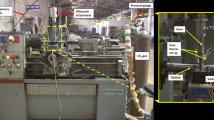Abstract
An elasto-plastic incremental finite element computer code based on an updated Lagrangian formulation was developed to simulate the V-die coining bend process of sheet metal under the plane-strain condition. A modified Coulomb’s friction law was introduced to treat the alternation of the sliding–sticking state of friction at the contact interface. The r-minimum method was used to treat the elastic–plastic stress state and to solve contact problems at the tool–metal interface. V-bends of sheet metals are classified according to the number of contact points of the sheet with the bending die, and include air bends, bottoming bends, and coining bends. The former has three contact points with the bending die at the punch top and die shoulders, and there have been many experimental and analytical research works reported on it. The latter two are in contact at a greater number of points. To clarify the bending characteristics, it is necessary to fully understand the process and stress state in the bent part. The experiment was performed to validate the theoretical formulation and to support the development of the computer code. Simulation was performed on the punch load of the coining bend and the bend angle of the bent part after unloading. Calculated sheet geometries and the forming force agree well with the experimental data. The simulation clearly demonstrates the efficiency of the code to simulate V-die coining bend processes that proceed under contact history.
Similar content being viewed by others
References
Lange K (1985) Handbook of metal forming. McGraw-Hill, New York
Magnusson C, Tan Z (1990) Mathematical modeling of V-die bending process. In: Proceedings of 16th Biannual IDDRG Congress, Stockholm, Sweden, May 1990, pp 363–370
Queener CA, De Angelis RJ (1968) Elastic springback and residual stresses in sheet metal formed by bending. Trans ASME 61(4):757–768
Duncan JL, Bird JE (1978) Die forming approximations for aluminium sheet. Sheet Met Ind 55(9):1015–1025
Levy BS (1984) Empirically derived equations for predicting springback in bending. J Appl Metalwork 3(2):135–141
Forcellese A, Fratini L, Gabrielli F, Micari F (1996) Computer aided engineering of the sheet bending process. J Mater Process Technol 60(1):225–232
Huang YM, Lu YH, Makinouchi A (1992) Elasto-plastic finite-element analysis of V-shape sheet bending. J Mater Process Technol 35(2):129–150
Prior AM (1994) Applications of implicit and explicit finite element techniques to metal forming. J Mater Process Technol 45(1–4):649–656
Finn MJ, Galbraith PC, Wu L, Hallquist JO, Lum L, Lin T-L (1995) Use of a coupled explicit-implicit solver for calculating spring-back in automotive body panels. J Mater Process Technol 50(1):395–409
Huang Y-M, Leu D-K (1995) An elasto-plastic finite element analysis of sheet metal U-bending process. J Mater Process Technol 48(1):151–157
Tekiner Z (2004) An experimental study on the examination of springback of sheet metals with several thicknesses and properties in bending dies. J Mater Process Technol 145(1):109–117
Xu WL, Ma CH, Li CH, Feng WJ (2004) Sensitive factors in springback simulation for sheet metal forming. J Mater Process Technol 151(1–3):217–222
Andersson A, Holmberg S (2002) Simulation and verification of different parameters effect on springback results. In: Proceedings of NUMISHEET 2002, Jeju Island, Korea, October 2002, pp 201–206
Wagoner RH, Li M (2005) Advances in springback. In: Proceedings of NUMISHEET 2005, Detroit, Michigan, August 2005, pp 209–214
He N, Wagoner RH (1996) Springback simulation in sheet metal forming. In: Proceedings of NUMISHEET 1996, Dearborn, Michigan, September 1996, pp 308–315
Diao F, Zhang K (2002) Dynamic explicit finite element analysis of springback of sheet V-bending. School of Materials Science and Engineering, Harbin Institute of Technology, Harbin, China, vol 10, no 2, pp 170–174
Huang YM, Leu DK (1998) Effects of process variables on V-die bending process of steel sheet. Int J Mech Sci 40(7):631–650
Zhang LC, Lu G, Leong SC (1997) V-shaped sheet forming by deformable punches. J Mater Process Technol 63(1–3):134–139
Huang YM, Chen TC (2004) An influence of tool profiles on the V-bending process of sheet metal. Key Eng Mater 274–276:553–558
McMeeking RM, Rice JR (1975) Finite-element formulations for problems of large elastic-plastic deformation. Int J Solids Struct 11:601–606
Huang YM, Leu DK (1996) Finite element analysis of contact problems for a sheet metal bending process. Compos Struct 57(1):15–27
Yamada Y, Yoshimura N, Sakurai T (1968) Plastic stress-strain matrix and its application for the solution of elastic-plastic problems by the finite element method. Int J Mech Sci 10:343–354
Author information
Authors and Affiliations
Corresponding author
Rights and permissions
About this article
Cite this article
Huang, YM. Finite element analysis on the V-die coining bend process of steel metal. Int J Adv Manuf Technol 34, 287–294 (2007). https://doi.org/10.1007/s00170-007-1054-4
Received:
Accepted:
Published:
Issue Date:
DOI: https://doi.org/10.1007/s00170-007-1054-4




